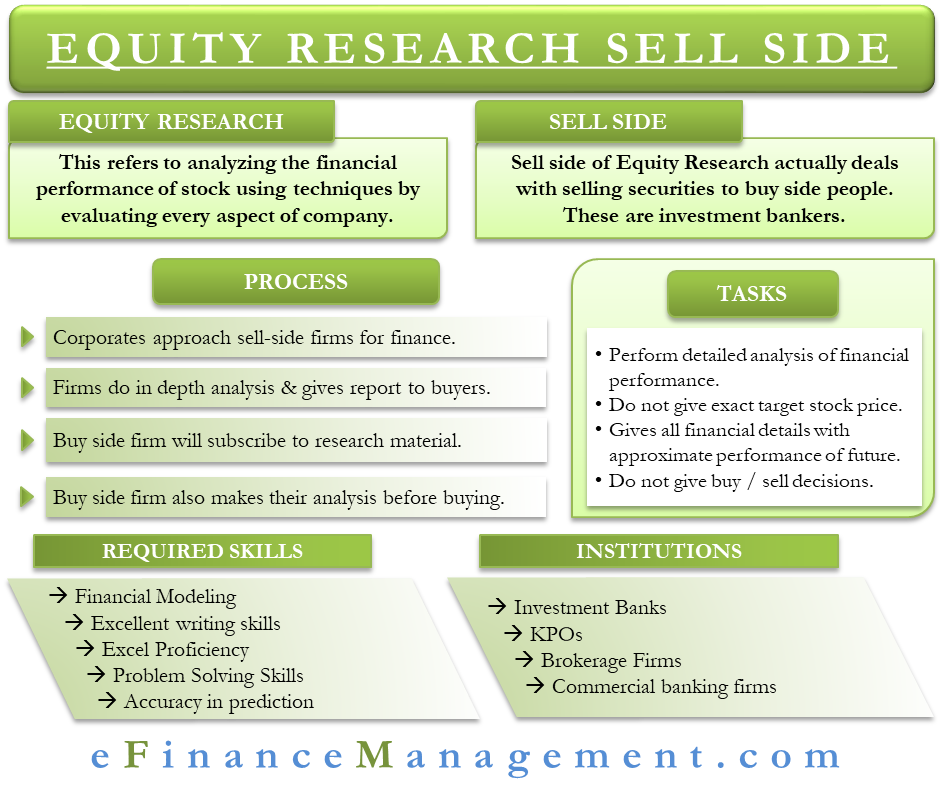Equity research sell-side is a common term used by many people in the financial services industry. You will wonder what does this means? Let us get into the details and understand what it is.
What is Equity Research?
Equity research is a branch of financial analysis that involves analyzing a stock’s financial performance (company). In order to analyze, it uses techniques like financial modeling and ratio analysis to provide insights into a particular stock. Exhaustive research is conducted by analyzing the company’s financial statements, predicting the future performance of a stock, and finding its target price. A detailed research report is also prepared by explaining every aspect of the company, its past and future financial performance, industry performance, etc. Investors (including retail and institutional investors) use this research report published by equity research analysts to make informed investment decisions. People who perform equity research are equity research analysts.
Read more about Equity Research.
What is Equity Research Sell-side?
Types of the Equity Research Market
An equity market comprises of Buy-side and Sell-side. As the name suggests, Buy-side people are involved in buying the securities, whereas sell-side people sell those securities to buy-side people. The difference between the two branches of equity research is based on the type of clients they serve.
Buy-side people are institutional investors, pension funds, mutual funds, venture capital firms, etc.
Sell-side people are investment bankers who facilitate selling securities to buy-side firms and other investors. For example, broking, investment banking, investment research companies, etc., come under this category. They are the ones who assist corporates in raising money. Consequently, creating securities in different asset classes, promoting them to investors, and helping sell those securities to retail and institutional investors and buy-side firms.
Also Read: Equity Research Buy-Side

Example
Let us consider the following example to clearly understand the role of sell-side firms in the financial market.
Let us assume there is Company X, which needs to raise money for its capital needs. It will then approach sell-side companies like investment banks and explain their needs. Analysts working at sell-side firms will then conduct detailed research on the company. They analyze its financial performance and industry performance using financial modeling and come up with an ‘ideal’ valuation for the company. The stock/bond is then launched in the market, and sell-side firms conduct the research work. This research material works as promotional stuff by buy-side firms to understand the company better before buying it.
Sell-side firms are mediators that connect corporates and buy-side firms for some fees and commission in return. The research material prepared by them is publicly available to all the investors in order to help them understand more about a particular stock or bond.
So, the process goes like this:
- Corporates approach sell-side firms to help them raise money
- These firms conduct in-depth research about the company and make the research material available to Buy-side firms
- Buy-side firms will subscribe to the research work provided by Sell-side firms to make informed decisions about the stock. They will, however, not rely entirely on this material.
- Buy-side firms conduct their research before making a buy or sell decision to determine the exact to the best price to enter a stock or a bond.
Work of a Sell-Side Analyst
The job of a sell-side equity research analyst is to perform a detailed analysis of the financial performance of companies or stocks on behalf of the corporates. Therefore, retail and institutional investors and Buy-side firms are the clients for such research reports. They don’t need to derive an exact target price for the company. They do not concentrate on the accuracy of the figure compared to buy-side firms. Their job is to put across the financial details of a company with approximate estimates of its future financial performance. They give a buy or sell recommendation on the stock, supported by investment arguments. However, buy-side firms will never go by this recommendation and conduct their research before investing in a stock.
Sell-side analysts have to closely study the company and perform exhaustive fundamental analysis of stocks and predict their future financial performance. They usually refer to so many sources for information before publishing their work. The research work done by a sell-side analyst is available publicly to all the investors.
Buy-side analysts rely heavily on the work done by sell-side analysts. They look for research material developed by sell-side analysts from various sources and use them in their research work before recommending a stock.
Skills Required for a Sell-Side Analyst
Skills required by a sell-side analyst are
- financial modeling,
- excellent writing skills,
- proficiency in excel,
- attention to detail,
- problem-solving skills,
- accuracy in prediction, and
- ability to give appropriate buy or sell recommendations
Institutions Where a Buy-Side Analyst Can Work
The following are the types of institutions that have dedicated teams for performing buy-side research.
- Investment banks
- KPO
- Brokerage firms
- Commercial banking firms
Compensation
The compensation for a sell-side analyst is slightly lower than a buy-side analyst. The average salary earned by a sell-side equity research analyst in the US is approximately $65,000 per annum.
Must read: Equity Research Buy-Side


Appreciate your time and efforts in making this concept so simple for a layman to understand. Did help alot.